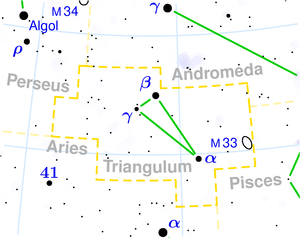|
|
Triangulum (Latin: Triangle) is a small northern constellation whose three brightest stars, of third and fourth magnitude, form a nearly-isosceles long and narrow triangle. It is one of the 88 modern constellations, and also one of the 48 listed by Ptolemy. Notable features Triangulum doesn't have stars of the first magnitude. Its brightest star is the white giant star β Trianguli (3.00m) with a close, dimmer companion. Its second-brightest star, the yellow-white subgiant star α Trianguli (3.41m) with a close dimmer companion, is also known as Caput Trianguli, and is at the apex of the triangle. 6 Trianguli, (known in some older sources as ι), is an "attractive double star with a noticeable color contrast" that can be split by medium-sized telescopes into a strong yellow and a pale blue star. Both components are themselves close binaries.[1] Notable deep sky objects Triangulum is the location of the Triangulum Galaxy, M33, also known as the great Pinwheel Galaxy. A distant member of the Local Group, it is about 2.9 million light years away, and at magnitude 5.8, it is bright enough to be seen by the naked eye under the darkest skies. Under light-polluted skies, it is challenging or invisible even in a small telescope or binoculars. Because of its low surface brightness, low power is required. In addition to M33, there are several NGC galaxies, all with magnitudes fainter than 11. The largest of these include the 10 arcminute long magnitude 12 NGC 925 spiral galaxy and the 5 arcminute long magnitude 11.6 NGC 672 barred spiral galaxy. History and mythology An early name of the constellation was Sicilia, because Ceres, patron goddess of Sicily, was claimed to have begged Jupiter that the island be placed in the heavens. See also * Triangulum Australe * Triangulum Minor Citations 1. ^ Robert Burnham, Jr (1978). Burnham's Celestial Handbook, Dover Publications, New York. ISBN 0-486-24065-7 References * Ian Ridpath and Wil Tirion (2007). Stars and Planets Guide Links
Retrieved from "http://en.wikipedia.org/"
|
|
||||||||||||||||||||||||||||||||||||||||||||||||||||
